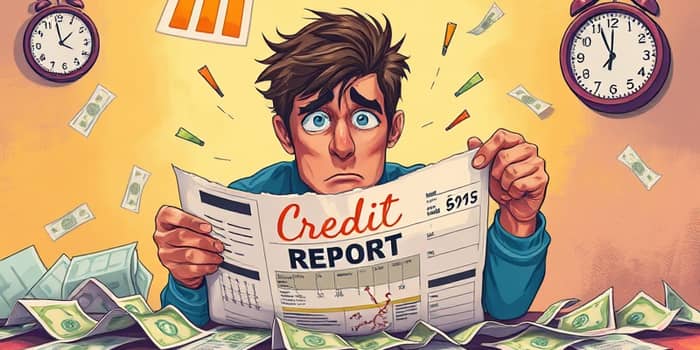Late payments on loans or credit cards can strike at the heart of your financial reputation. A strong credit score unlocks lower interest rates, favorable loan terms, and better insurance premiums. Conversely, a missed payment can set off a cascade of negative consequences that linger for years. Understanding how and when these delinquencies are reported, and learning strategies to prevent or mitigate them, will empower you to seize control of your financial future.
In this comprehensive guide, we explore the lifecycle of a late payment: from the initial grace period to potential referral to collections. We will analyze how credit scoring models respond, preview recent industry trends, and offer practical tips for both consumers and businesses. By the end, you will have clear, actionable steps to avoid pitfalls and, if necessary, recover from missteps.
Definition and Reporting Timeline
By industry standards, a payment must typically be at least thirty days overdue before it is formally reported to credit bureaus. During this initial grace period, lenders may send reminders or charge late fees, but they refrain from alerting the credit reporting agencies. Once that thirty-day mark is crossed, late payments remain on your report and begin to chip away at your creditworthiness.
It is important to note that not all issuers handle partial payments the same way. Some may report an account as delinquent even if a partial amount is paid. Early communication with creditors and confirming how they track payments can help you avoid unexpected surprises on your credit report.
Consumers are entitled to at least one free credit report per year from each major bureau. Reviewing these records ensures you spot any unexpected late entries and initiate disputes promptly. Error rates in reporting can occur, and timely challenges may remove erroneous marks before they deeply impact your score.
The Severity Scale of Late Payments
The impact of a late payment intensifies with time. As the number of overdue days grows, so do the penalties, interest rate hikes, and risk of account closure. The following table summarizes the common thresholds and their consequences:
After 120 days of delinquency, an account is usually handed over to collections, and the damage compounds over time. Each stage remains visible on your credit report for up to seven years, although its influence may lessen if you avoid further missteps.
At the 30–59 day threshold, lenders may still respond to courtesy calls and arrangements. However, once you cross into the 60–89 day window, your account transitions into a higher risk category, potentially triggering penalty interest rate hikes and late fee acceleration. By the time you hit 90 days, your lender’s internal collection department intensifies contact efforts, and you could face restrictions on future borrowing until the delinquency is resolved.
Quantitative and Industry Trends
Research shows that a single late payment can lead to a staggering drop of up to 100 points on your FICO score, depending on your overall credit profile and the severity of the delinquency. Payment history accounts for 35% of the FICO formula and around 40% of the VantageScore calculation. Recent statistics from 2025 indicate a rise in auto loan delinquencies, contributing to a average VantageScore dropping to 701 nationwide.
In a month-over-month analysis, late-stage delinquencies climbed by 0.25%, driven in part by student loan burdens and rising living costs. The takeaway is clear: the more recent and frequent your late payments, the greater the setback to your score. Industry data suggests that certain account types, such as auto and student loans, are more prone to report delinquencies, intensifying their influence on your credit profile.
It is also worth noting that different credit scoring models handle late payments uniquely. For instance, some versions of VantageScore place slightly more emphasis on the most recent 24 months of history, meaning a late payment that is two years old may have less influence under that system. However, FICO models generally maintain a longer view of your payment record, underscoring the long-term ramifications of a single slip.
Several key factors dictate how severely a late payment impacts your score:
- Frequency of delinquencies: repeated offenses amplify damage
- Length of delinquency: longer delays trigger steeper penalties
- Type of account: installment loans vs. revolving credit
- Overall payment history: a pristine record may cushion the blow
Business Implications
Late payments are not solely a consumer concern; they have profound effects on businesses of all sizes. Cash flow disruptions can stall operations, forcing companies to delay payroll or cut expenses. Proactive steps are essential to maintain financial stability and professional relationships.
Experts recommend adopting proactive credit control measures for businesses to combat rising delinquencies:
- Conduct regular credit checks on new and existing clients
- Establish clear payment terms and enforce them consistently
- Implement invoice automation to streamline billing and reminders
- Maintain open communication channels with customers to resolve disputes swiftly
By treating accounts receivable as a critical asset, businesses can reduce late payments and preserve healthy cash flow. A well-structured credit policy paired with automated tools ensures that invoices are sent promptly and followed up on schedule.
Small businesses often feel the sting of just one overdue invoice, while larger enterprises may spread the risk across multiple accounts. Yet regardless of size, a pattern of late payments from customers can erode supplier trust and lead to stricter trade credit terms. By deploying analytics to track payment trends and prioritizing high-value clients, companies can tailor their outreach and negotiation tactics for more efficient collections.
Recovery Strategies and Prevention Tips
Recovering from a late payment requires patience and discipline. As time passes, the effect of a missed payment diminishes, particularly if you sustain an otherwise clean payment history. Monitoring your credit score and reviewing your credit report at least annually helps you identify and dispute any inaccurate entries.
To prevent late payments in the future, consider adopting these practical measures:
- Set up automatic payments or reminders to ensure on-time transfers
- Negotiate hardship programs or modified plans with creditors early
- Allocate a portion of each paycheck to a dedicated bill-paying account
- positive payment history can rebuild trust with lenders over time
If your score has suffered, consider opening a secured credit card or small installment loan designed for credit rebuilding. Making on-time payments on these new accounts establishes a fresh track record. Additionally, many credit counseling agencies offer structured programs to assist with debt management, consolidating balances into a single monthly payment and providing financial education.
For businesses, combining robust invoicing software with periodic performance reviews can minimize unintentional oversights and reinforce accountability. Consumers benefit from leveraging free credit monitoring tools to stay abreast of changes and rectify errors promptly.
Although a late payment can feel devastating, it is not the end of your financial journey. By understanding the reporting process, appreciating the scale of consequences, and implementing targeted strategies, you can protect and ultimately restore your credit health. Remember that each on-time payment you make serves as a building block toward a stronger, more resilient financial future.
While the path to recovery can be long, remember that credit health is not static. Every positive action you take—no matter how small—contributes to a more robust profile. By staying informed, diligent, and proactive, you can transform past mistakes into stepping stones toward financial stability and opportunity.
References
- https://www.nerdwallet.com/article/finance/late-bill-payment-reported
- https://www.equifax.com/personal/education/credit-cards/articles/-/learn/when-late-credit-card-payments-post/
- https://www.myfico.com/credit-education/credit-scores/payment-history
- https://www.lendingtree.com/credit-repair/how-missed-or-late-payment-affects-credit/
- https://www.chase.com/personal/credit-cards/education/build-credit/when-late-payments-show-up-on-credit-report
- https://vantagescore.com/resources/knowledge-center/press_releases/vantagescore-creditgauge-february-2025-auto-loans-flashed-caution-signs-as-late-payments-increase-average-vantagescore-declines/
- https://www.british-business-bank.co.uk/business-guidance/guidance-articles/finance/how-to-deal-with-late-payments
- https://www.capitalone.com/learn-grow/money-management/late-credit-card-payments/










